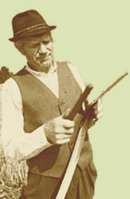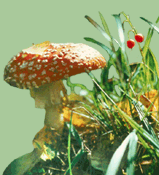Estonian rarities: Red Helleborine Orchid the Estonian Orchid of the Year
Tiiu Kull gives an overview of the state of the beautiful orchid in Estonia and elsewhere in the world and also introduces the aims of the International Year of Biodiversity of the UN. The red helleborine orchid (Cephalanthera rubra) is one of our largest and most beautiful orchids. It prefers calciferous soils, and is therefore more common in West-Estonia. It is a forest orchid that is threatened by forest felling. The author also explains the various ways of regeneration of the orchid.
A long road to nature protection badge
Vootele Hansen looks back at the history of founding the nature protection badge in the late 1930ies. The first nature protection law in Estonia was enacted in 1935 and based on that law, nature protection badges could have been awarded to people active in nature protection field. However, it took about five years before the statute and the design of the badge were worked out: in February 1940 the statute of the badge was finally sanctioned by the President of State (Konstantin Päts). The badge was officially awarded to 23 people. The article involves the list of the nominees and examples of the badge designs form 1937.
The time periods of Estonian protected areas
Teet Koitjärv proposes a novel way to mark the history Estonian nature protection, based, among other criteria, on the changes of political regimes. He differentiates between 6 stages of nature protection history: 1) until 1910 (time before protected areas); 2) 19101935 (academic nature protection with protected areas); 3) 19351944 (nature protection in Estonian Republic and in the following years of occupation); 4)19441957 (academic nature protection without state support); 5) 19571994 (state nature protection; cooperation between nature protection and forestry); 6) since 1994 (state nature protection in Estonian Republic; cooperation between nature protection and environmental protection).
Estonia Nature enquires
Lilika Käis summarizes the activities of the International Year of Biodiversity in Estonia.
Liina Eek explains the progress of compiling the nature protection development plan.
100 years of protected areas in Estonia
Hanno Zingel and Taimo Aasma look back at the beginning of the systematic network of protected areas and discuss the subsequent status quo and possible future developments. In the first Estonian Republic, the nature protection activities were mostly centered on defining natural monuments and taking these under protection. Most of the protected areas founded during the First Republic in 1920.-1930ies are still under protection, thus showing important continuity. In 1957 nature protection started to develop very fast: new protected areas were founded on state as well as on regional level. A new break-through happened in 1990ies when land was again turned into private property. As of today, Estonian network of protected areas consists of 5 national parks, 131 nature protection areas, 148 landscape protection areas and nature parks, 118 other protected areas, 544 protected parks, 343 Natura 2000 areas, 1038 habitats and 1203 single objects. The network covers very different types of areas, the most important and outstanding of which are, perhaps, the semi-natural communities and mires.
Why we need Natura 2000?
Kadri Möller gives an overview of the development of Natura 2000 areas, their aims and financing. Natura 2000 is a trans-European network of protected areas, which aims are defined by the Nature Directive and Birds Directive of the EU. In Estonia, the network encompasses 66 bird areas and 531 habitat areas, which largely overlap. The overall territory of Natura 2000 areas in Estonia is about 14 590 km2.
Estonian environmental organizations role in protecting nature
Helen Alumäe introduces the main environmental organizations that are essential in Estonian nature protection. Nine of them have gathered into the Estonian Council of Environmental NGOs, which is a an informal politically independent cooperation network that helps environmental activists jointly achieve the environmental protection goals that are important for all of us. But there are also many others, starting from those which foster classical academic nature protection to those, which integrate the basics of nature conservation to innovation and social development.
The history of fish protection and fish resources protection in Estonia
Aimar Rakko takes a glance at the protection of fish fauna and fish resources in the past and present. In Estonia, there are 7 protected fish species. The most important means of protection is the protection of habitats. The history of scientific research of fish resources dates back to Karl Ernst von Baer in 1851. Toady, one of the major tasks is to ensure supervision of fishing activities. It is estimated that a very large share of todays catch is illegal, thus leading to a serious scarcity of fish resources.
Interview: The captain of the environmental board comes from Hiiumaa
Toomas Jüriado has interviewed Andres Onemar, the head of the Estonian environmental board.
Nord Stream, a time bomb in the Baltic Sea
Ivar Puura summarizes the possible and certain threats related to the establishment of the gas pipe in our neighboring areas. The project can be called the biggest environmental threat of Estonia in the 21st century. About 1/4 of the pipeline will run in the Gulf of Finland, which is a very vulnerable environment due to its shallowness. So far, the results of environmental impact assessment are deficient and therefore the establishment and usage of the pipeline poses severe risks on the fauna of the Baltic Sea and on the health of people living around the Baltic Sea.
Blister beetles, insects with exciting lifestyle
Mati Martin invites the readers to take a notice of the blister beetles, whose distribution in Estonia is very unclear. In Estonia there are at least three species of the family. The blister beetles are different from other beetles in many ways: they look and act differently. The blister beetles go through several larval stages, the first of which is typically a mobile triungulin. The larvae are insectivorous, mainly attacking bees. The beetles exudate a poisonous chemical causing blistering of the skin. Although blister beetles are toxic, they taste well for hen and hedgehogs.
Protected mushrooms: Polyporus tuberaster
Erast Parmasto introduces a mushroom species, which is easily confused with a similar species Polyporus squamosus. While the latter always grows on tree trunks or stumps, the first only grows on ground. The species is considered rare, but as it is not much looked for, its real area of distribution may be much wider.
Tree of the Year: Bird cherry in folk traditions
Mall Hiiemäe and Astrid Tuisk explore the folk knowledge of bird cherry. Foremost, the bird cherry is known for its specific smell. The flowering time has been regarded as an omen for future yield and weather, for example. The authors also present numerous examples of folk tales regarded to bird cherry.
|


![[IN ENGLISH]](images/gb.gif)





